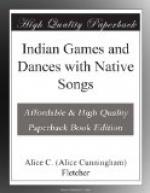Of the songs I heard in solitude, some were published over thirty years ago. Since then many of my gleaning have been used by different composers and the musical message sent far and wide.
With the Indian, words hold a secondary or an unimportant place in a song. The music and accompanying action, ceremonial or otherwise, convey the meaning or purpose. When words are used they are few, fragmentary and generally eked out with vocables. Frequently only vocables are attached to a melody. To the Indian, song holds a place similar to that filled for us by wordless instrumental music. In ceremonies, rituals occur that are always rhythmically intoned; each line generally terminates in a refrain. Songs have a place in these rituals, breaking in on the recital particularly when an emotion is evoked, for music is the medium of emotional expression. An old Indian priest explained this peculiarity by saying: “Harmonious sounds unite the people.”
Unaccustomed as we are to the use of songs that have no words, we would not only find it difficult to understand their meaning but we would lose much pleasure when singing them. To obviate the perplexities arising from the Indian’s peculiar treatment of words and to make clear the meaning of a song, words have been supplied. These words are in no instance a literal translation, for the few broken words that belong to some of the melodies used in these Dances and Games, because of their fragmentary character, would have no value as an interpretation either of the music or of the action. In a number of instances the original vocables are retained, where the music is merely a rhythmical accompaniment to a simple, easily understood movement. Where words are given to a song, they follow closely both the accents and the rhythm of the music. The written stanzas are not meant to be read but to be sung. They express the thought or the feeling that gave rise to the music, they aim to make its meaning understood so that the song can be intelligently sung. In arranging these words, care has been taken never to forget or to change the natural and the psychical environment that belongs to the melody.
Indian songs are very short. They have no preliminary measures, but at once voice the actuating emotion; that done, they come to a close. Although they are so short, they have form and in their structure follow in simple lines the rules of phrasing and motivization taught in our schools. These songs, speaking in general terms, partake more of the character of motifs than of musical compositions. They do not stand alone or apart from the ceremonials or pleasures of which they form an essential feature.
THE DANCE
The different Indian tribes vary in their modes of dancing; moreover, the same theme is not interpreted by all the tribes in the same manner. In some sections of our country the dancers wear costumes and masks that are symbolic, both in color and form; in other regions, feathers are the principal and emblematic decoration; elsewhere, the men may dance very nearly nude. However diverse the dancing regalia may be or how marked its absence, the Indian dance always presents two characteristics, namely: Dramatic Action and Rhythmic Precision.




